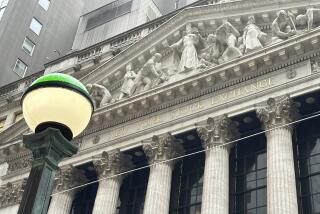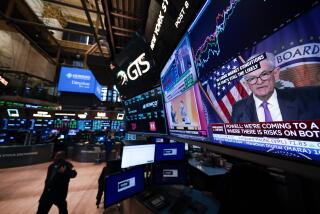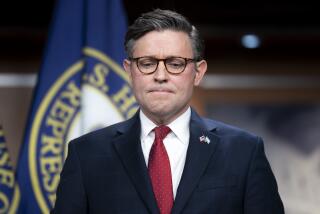Surprise warning on U.S. debt comes as Washington inches away from gridlock
Reporting from Washington and Los Angeles — An unexpected warning about America’s soaring debt jolted financial markets and threatens wider consequences for the U.S. economy, even as a new sense of realism emerges in the stalemate between President Obama and congressional Republicans over fiscal policy.
The shot across the government’s bow came from Standard & Poor’s, a leading credit rating firm, which served notice that there was a 1-in-3 chance that it would lower the now-sterling AAA rating on U.S. debt in the next two years.
The mere prospect of such a downgrade, which until recently was considered unthinkable, could drive most U.S. interest rates higher, imposing new strains on consumers and the still-fragile economic recovery.
S&P said it still considered the U.S. to be worthy of the highest credit rating, but that failure to address mounting budget deficits by 2013 would leave the country’s finances “meaningfully weaker” than those of other AAA-rated nations, such as Germany and Singapore.
Because of that risk, S&P reduced its outlook for the U.S. rating to “negative” from “stable.” Changing the outlook often is a first step toward cutting a rating.
The White House dismissed S&P’s move Monday as a “political judgment” that failed to recognize America’s long history of political opponents’ coming together in times of crisis. And after weeks of often bellicose sparring over federal spending, there were signs that a deal might be in the making — at least on the most immediate issue of raising the nation’s debt ceiling.
In recent days, GOP congressional leaders as well as the president have issued pledges to get the ceiling raised in a timely fashion. Obama acknowledged that an agreement would entail new commitments on deficit reduction, and Republicans promised to find common ground even though they still have huge differences with Democrats on spending and taxes.
“This debate has moved into a different realm,” said R. Bruce Josten, chief lobbyist for the U.S. Chamber of Commerce. His organization and other business groups have been working to persuade Republicans not to hold up debt ceiling legislation.
Josten said he had become more optimistic that a damaging confrontation could be avoided.
“There are so many negotiations over concessions that it is like a plate-spinning contest,” he said. Still, regarding the likelihood of a deal, Josten said, “I think it’s going to happen.”
The change in Washington’s political climate appeared to stem from a growing recognition on both sides that failure to raise the debt ceiling and offer at least the possibility of a less partisan approach to the overall deficit problem could have severely damaging consequences for the economy — and for politicians.
The national debt will hit its $14.3-trillion ceiling, its current legal cap, in a matter of weeks.
Josten and other business leaders have been conducting a low-profile but intense lobbying effort to bring aboard skeptical conservatives in Congress, many of whom the business groups backed financially in last year’s election.
In addition to one-on-one lobbying, the Chamber of Commerce has brought prominent business leaders to Washington to drive home the seriousness of the debt limit issue.
“If the United States actually defaults on our debt, it would be catastrophic,” Jamie Dimon, chief executive of JPMorgan Chase & Co., warned at a recent chamber forum in Washington. “If anyone wants to push that button … they’re crazy.”
The action by S&P, coming on a day when markets abroad already were fretting over Europe’s worsening debt crisis, unnerved investors, many of whom — like the American public — have long regarded the spiraling U.S. debt as a problem for the future, not the present.
S&P’s warning raises the risks that global investors will view U.S. government bonds as riskier than they do now, forcing the Treasury to pay higher interest rates on newly issued debt. That could mean higher interest costs for American consumers and businesses as well.
“It’s a serious step,” said Chris Rupkey, senior financial economist at the Bank of Tokyo-Mitsubishi in New York. At a time when rising energy costs are weighing on businesses and consumers, he said, “this is another head wind facing the economy.”
But the possibility of a drop in the nation’s credit rating didn’t play out on Wall Street entirely as might have been expected. Market interest rates on U.S. Treasury bonds initially rose after S&P issued its statement, but then quickly fell back, demonstrating that the securities remain a favorite haven for many investors in times of global turmoil.
Investors in stocks also appeared to moderate their view on the effect of S&P’s announcement. The Dow Jones industrial average closed down 140.24 points, or 1.1%, to 12,201.59, paring what had been a 248-point drop.
Publicly, leaders of both parties reacted to S&P’s report with partisan criticisms.
“S&P sent a wake-up call to those in Washington asking Congress to blindly increase the debt limit,” said Rep. Eric Cantor (R-Va.), the House majority leader.
But behind the scenes, the ratings shift looked to spur the two sides to move toward a middle ground.
In its report, S&P expressed skepticism that Republican leaders and the president, who have proposed dueling deficit-cutting plans in recent days, could come together.
“The gap between the parties remains wide,” S&P analysts wrote.
But S&P’s main rival in the debt-rating business, Moody’s Investors Service, on Monday maintained its “stable” outlook on the nation’s credit rating. Moody’s analyst Steven Hess said that despite the gulf between the Obama administration’s deficit-reduction plan and that of Republican leaders, the two proposals represent “a turning point that is positive for the long-term fiscal position of the U.S. federal government.”
White House spokesman Jay Carney suggested that the warning from S&P might even serve as a useful reminder to Congress that failing to raise the debt ceiling carries grave consequences.
“I would say that any call for a bipartisan agreement on deficit reduction — fiscal reform — is a welcome one and in that context it adds to what we believe is some momentum toward that end,” Carney said.
Some congressional leaders gave little indication of moving from their hard-line positions, but others said the downgrade warning was evidence of the need to resolve partisan disputes and swiftly improve the nation’s fiscal outlook.
“Today’s revised outlook [by S&P] shows the urgent, bipartisan action needed to put our nation on a serious path to reduce deficits,” said the No. 2 Democrat in the House, Rep. Steny H. Hoyer of Maryland. “Republicans cannot hold the debt limit hostage over partisan, divisive issues.”
Lisa Mascaro and Peter Nicholas in Washington and Nathaniel Popper in New York contributed to this report.
More to Read
Inside the business of entertainment
The Wide Shot brings you news, analysis and insights on everything from streaming wars to production — and what it all means for the future.
You may occasionally receive promotional content from the Los Angeles Times.











